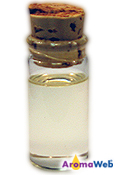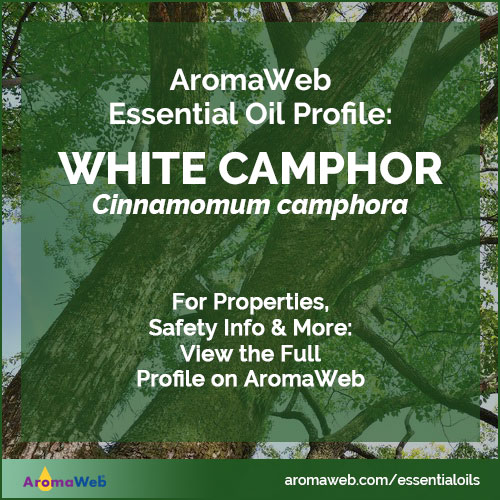White Camphor Essential Oil
Cinnamomum camphora

Description
The term camphor can apply to Camphor Essential Oil, but it can also apply to the tree that the wood is distilled from. It can also apply to the specific constituent known as camphor. When discussing or reading about camphor, it's important to understand whether it's the whole essential oil that is being discussed or if it's the constituent.
The chemical constituent known as camphor is a ketone. Interestingly, White Camphor Essential Oil contains only a trace to a small percentage of the constituent camphor.

White Camphor Essential Oil is a rectified oil. To produce the oil, crude camphor is collected from the trees and is steam distilled into fractions, namely white camphor, brown camphor, yellow camphor and blue camphor. [Sources: Maria Lis-Balchin, BSc, PhD, Aromatherapy Science (United Kingdom: Pharmaceutical Press, 2006), 135. Julia Lawless, The Illustrated Encyclopedia of Essential Oils (Rockport, MA: Element Books, 1995), 111.]
When sourcing White Camphor Essential Oil, it is crucial that you purchase it from a highly reputable source, and be certain that you are obtaining White Camphor Essential Oil. Brown Camphor Oil and Yellow Camphor Oil contain significant quantities of the toxic constituent safrole and are not safe for use.
White Camphor Essential Oil Benefits and Uses
- Muscular Aches and Pains
- Rheumatism
- Cough
- Bronchitis
- Colds
- Acne
- Rashes
- Parasitic Skin Infections
- Contusions
- Bruises
- Insect Repellent
Source: Valerie Ann Worwood, The Complete Book of Essential Oils and Aromatherapy, 25th Anniversary Edition (Novato, CA: New World Library, 2016, 573.
Botanical Name
Plant Family
Common Method of Extraction
Steam Distilled
Plant Part Typically Used
Color
Clear
Consistency
Thin
Perfumery Note
Middle
Strength of Initial Aroma
Strong
Aromatic Description
White Camphor Essential Oil smells fresh, intense and woody. Its aroma is somewhat eucalyptus-like due to its high cineole content.
Major Constituents
- (+)-Limonene
- p-Cymene
- a-Pinene
- 1,8-Cineole
- Sabinene
- B-Pinene
- Camphene
- Camphor
See Essential Oil Safety for more complete list of typical constituents.
Source: Private Communication: Burfield, 2003. Source cited in Robert Tisserand and Rodney Young, Essential Oil Safety (Second Edition. United Kingdom: Churchill Livingstone Elsevier, 2014), 228.
White Camphor Essential Oil Safety Information
Due to its 1,8 cineole content, it is best not to use Camphor Essential Oil around young children.
Tisserand and Young warn that old and oxidized oils should not be used. Reading Tisserand and Young's full profile is recommended. [Robert Tisserand and Rodney Young, Essential Oil Safety (Second Edition. United Kingdom: Churchill Livingstone Elsevier, 2014), 228.]
General Safety Information
Do not take any oils internally and do not apply undiluted essential oils, absolutes, CO2s or other concentrated essences onto the skin without advanced essential oil knowledge or consultation from a qualified aromatherapy practitioner. For general dilution information, read AromaWeb's Guide to Diluting Essential Oils. If you are pregnant, epileptic, have liver damage, have cancer, or have any other medical problem, use oils only under the proper guidance of a qualified aromatherapy practitioner. Use extreme caution when using oils with children and be sure to first read the recommended dilution ratios for children. Consult a qualified aromatherapy practitioner before using oils with children, the elderly, if you have medical issues or are taking medications. Before using this or any essential oil, carefully read AromaWeb's Essential Oil Safety Information page. For in-depth information on oil safety issues, read Essential Oil Safety by Robert Tisserand and Rodney Young.
Shelf Life
Important Information About the Profiles
The essential oil information provided on AromaWeb is intended for basic educational purposes only. The references to safety information, test results, constituents and percentages is generalized information. Essential oils can vary greatly in composition. The data is not necessary complete and is not guaranteed to be accurate. The essential oil photos are intended to represent the typical and approximate color of each essential oil. However, essential oil composition and color can vary based on harvesting, distillation, age of the essential oil and other factors. Profiles for several CO2 Extracts and absolutes are included within the directory, and are denoted as such.
